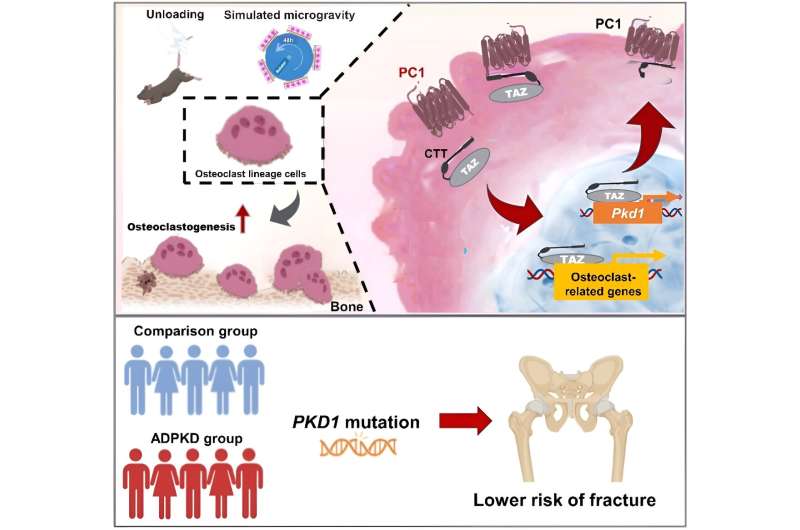This article has been reviewed according to Science X's editorial process and policies. Editors have highlighted the following attributes while ensuring the content's credibility:
fact-checked
trusted source
proofread
Researchers reveal a novel mechanism of mechanical regulation of bone homeostasis

Professor Changjun Li and his colleagues at Xiangya Hospital of Central South University have published a research paper titled "Mechanical protein polycystin-1 directly regulates osteoclastogenesis and bone resorption" in Science Bulletin.
In the paper, the authors point out that mechanical loading is required for bone homeostasis, but that the underlying mechanism is still unclear. Their research has found that mechanosensitive protein polycystin-1 (PC1, encoded by Pkd1) plays an important role in osteoclast-mediated bone resorption.
The authors conducted a cohort study of 32,500 patients and found that patients with autosomal dominant polycystic kidney disease, which is mainly caused by loss-of-function mutation of the PKD1 gene, had a significantly lower risk of hip fracture than those with other chronic kidney diseases. Furthermore, the conditional deletion of Pkd1 in the osteoclast lineage resulted in decreased bone resorption, increased bone mass and complete resistance to unloading-induced bone loss.
A mechanistic study revealed that PC1 facilitated TAZ nuclear translocation via the C-terminal domain, thereby increasing the transcription of osteoclast-related genes, and that conditional deletion of Taz in the osteoclast lineage resulted in reduced osteoclastogenesis and increased bone mass. Pharmacological regulation of the PC1-TAZ axis alleviated unloading- and estrogen deficiency-induced bone loss.
The research team elucidates a new mechanism by which mechanical loading could directly regulate bone resorption and affect bone homeostasis, which provides a potential new therapeutic target for the prevention and treatment of osteoclast-related osteoporosis.
Mei Huang, an assistant researcher in Xiangya Hospital of Central South University, is the first author of the paper. Prof. Changjun Li, Prof. Guanghua Lei, Prof. Xianghang Luo and Prof. Chao Zeng are co-corresponding authors.
More information: Mei Huang et al, Mechanical protein polycystin-1 directly regulates osteoclastogenesis and bone resorption, Science Bulletin (2024). DOI: 10.1016/j.scib.2024.04.044

















